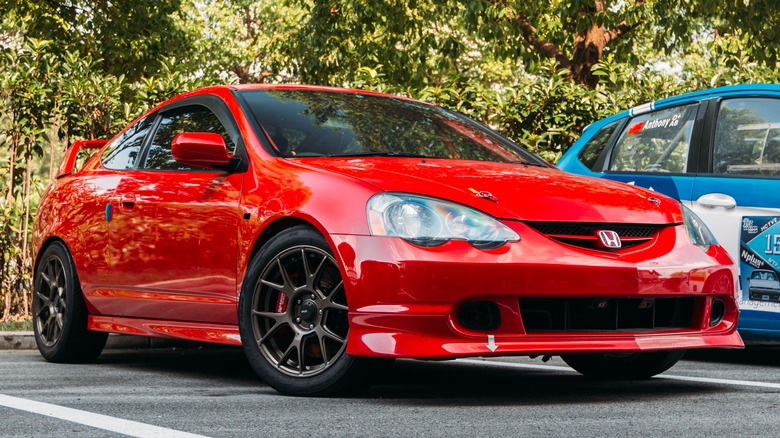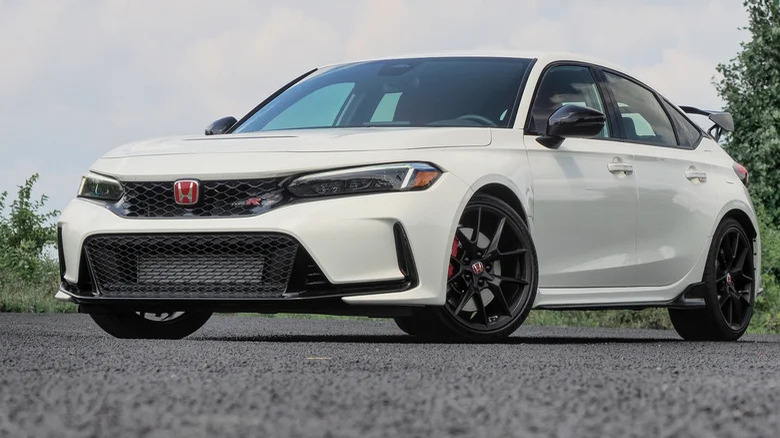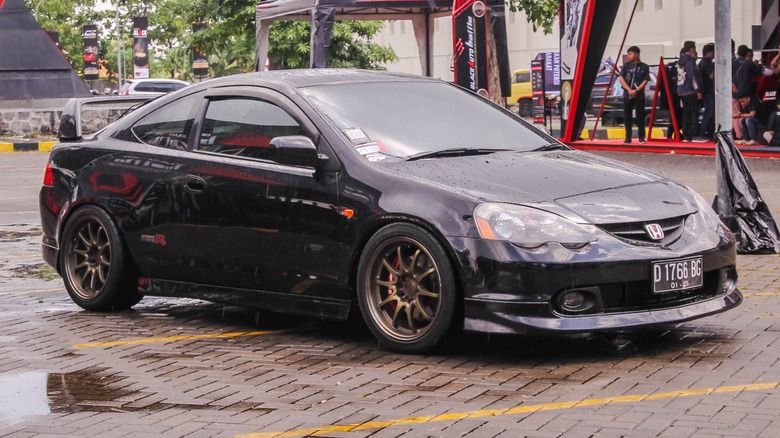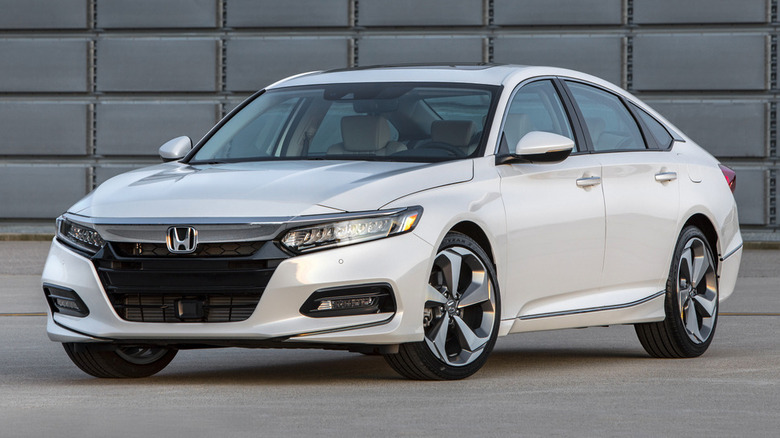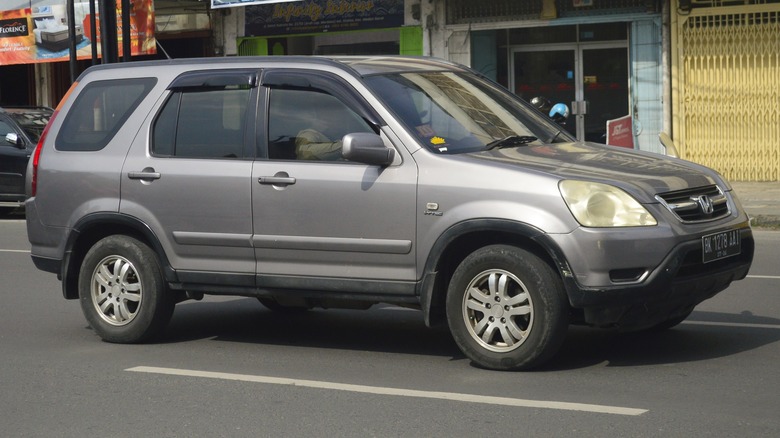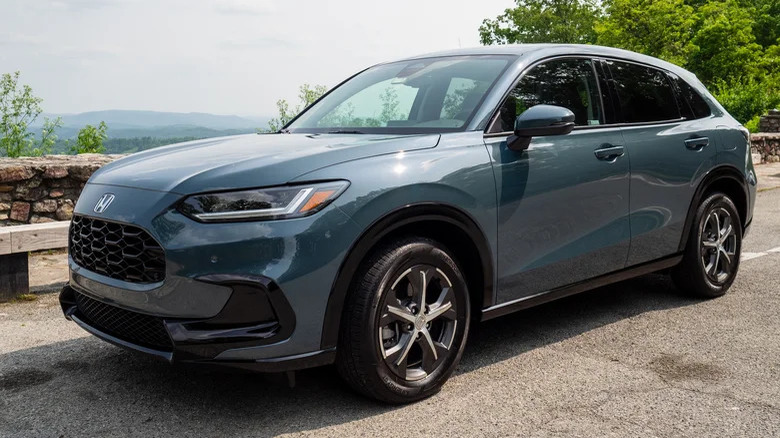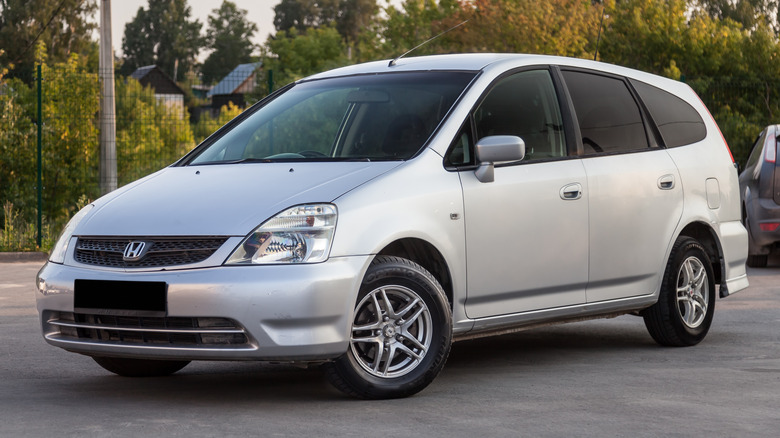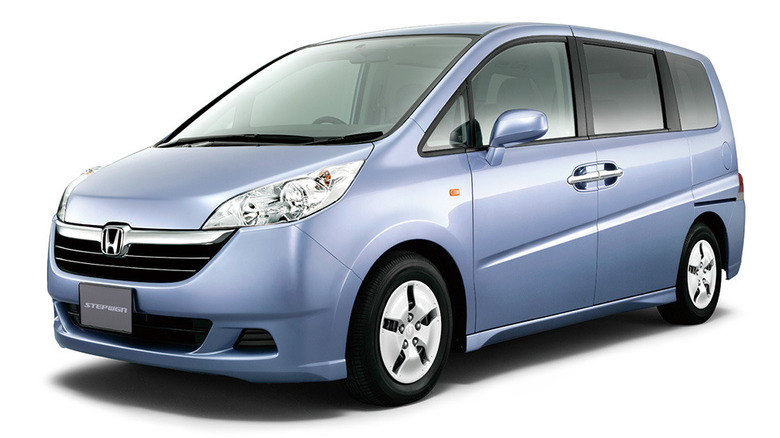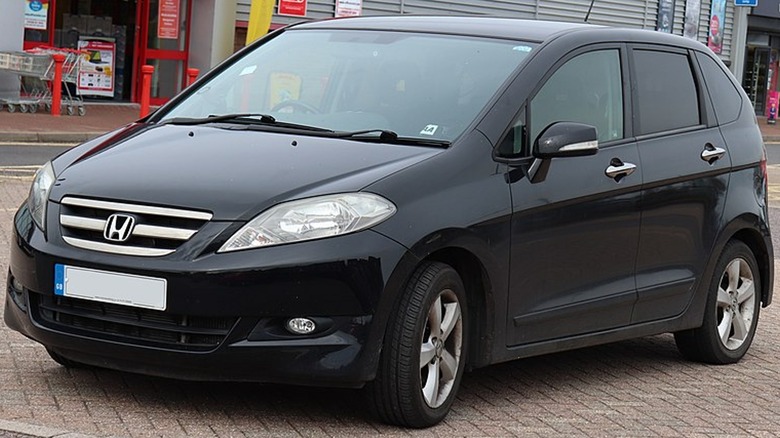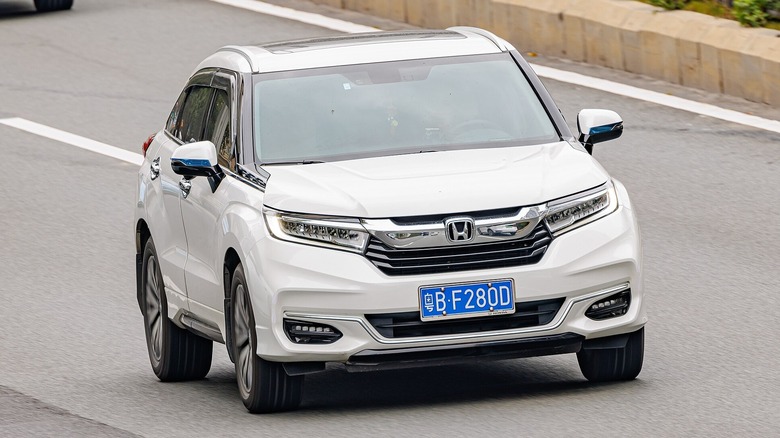Every Honda Model Powered By The K20 Engine
Honda's line of K-Series four-cylinder engines is one of the Japanese automaker's most noteworthy, and can be found under the hoods of a broad range of Honda models. It was first introduced at the turn of the century but thanks to its popularity with buyers and impressive efficiency, it's still in use today. Efficiency is far from the K-Series' only talent, however -– many K-Series variants are also considered highly reliable and readily tunable, which has made them a long-time favorite with enthusiasts.
The K20 is the 2.0L variant of the line, and has been built in a number of distinct iterations over its more than two decades on sale. It has appeared in various Acura models and even in a highly modified form at the core of the crazy Ariel Atom, but here we're focusing only on the Honda models it has appeared in to date. From a track-ready hot hatch to a JDM minivan, the K-Series is more prolific across Honda's range than many enthusiasts might initially assume.
Honda Civic
Arguably the most famous application of the K20 engine is in the Civic Type R. The K20 debuted under the hood of the EP3 Type R in 2001 and instantly became a hit thanks to its high-revving nature and ample power. From 2001 to 2011, the Type R featured the K20A, and then from the launch of the FK2 generation, it was replaced by the K20C1. The current generation Civic Type R continues to use an evolution of the same engine, now churning out 315 horsepower and 310 lb-ft of torque.
It's not just the top-spec Civic that uses a K20 engine either. A variety of K20 variants have been used across the whole Civic range since its initial appearance in the Type R, with the 2006 Civic Si and Civic sedan also featuring the engine. These earlier K20 powered cars sported a K20Z3, while more recent 10th and 11th generation Civics use a K20C2. Each iteration uses a slightly different VTEC configuration, with most models prioritizing efficiency over all-out power. Of course, that's excluding the Type R, which in its current form is the most capable it has ever been on track or on the road.
Honda Integra
Although it was marketed under the Acura RSX nameplate in the U.S., in all other markets the fourth generation (DC5) Integra wore a Honda badge. It was sold between 2002 and 2006 and its K20 engine produced up to 220 horsepower. The top-spec Integra Type R was only ever officially sold in Japan, although a slightly detuned Integra Type R with 200 horsepower was also sold in New Zealand. A number of JDM cars also ended up in Europe as gray imports.
The DC5 Integra featured a larger engine than its predecessor the DC2, but it was also heavier. It never achieved the same acclaim as the DC2, and it was discontinued in 2006 without an immediate successor. The fifth generation Integra, launched in 2023, does not use a K20, instead packing a smaller 1.5L engine that's good for 200 horsepower. That's a 20 horsepower downgrade compared to the JDM DC5 Type R, but SlashGear's reviewer thought the 2023 Integra felt faster on the road than those figures would suggest.
Honda Accord
Alongside the Civic, another bestselling Honda model was also equipped with the K20 in the 2000s. Several variants of the Accord featured the K20A and its larger sibling, the K24A, replacing the F-Series engines that had been used through the 1990s. The K20 would continue to be used over following generations, with the most recent being the 10th generation Accord that launched for 2018. SlashGear drove the car at a preview event before its official launch and gave the K20C4 engine, which was completely redesigned from its predecessor, a thorough workout on track.
We were left impressed at the engine's power given its 2.0L displacement, having been encouraged to take the car well into triple digit speeds by Honda engineers. While it's safe to say that most Accord owners won't ever need to venture too far above highway speeds, it's always good to have the extra power on tap. Plus, many of them might be surprised just how easily the car hits its officially quoted top speed of 129 mph.
Honda CR-V
When the second generation Honda CR-V debuted in America in 2002, it did not feature a K20 engine. All American market cars received a 2.4L K24, but in other markets including Europe, the smaller 2.0L K20 was offered. It was subject to minor tweaks across its production run, mostly in order to meet the Euro IV regulations required for the 2005 model year. The K20 in the CR-V used an engine code not found on any other model – K20A4.
The CR-V was -– and remains -– an important model for Honda, as it has proved consistently popular with buyers over its quarter century on sale. It was the top-selling gas powered SUV in Europe for multiple years after it first launched, with the second generation car offered in over 160 countries around the world. Over 280,000 examples of the car were sold in 2003 across the K20, K24, and diesel-engined variants combined.
Honda HR-V
Marketed as the Honda HR-V in America and China and as the ZR-V in other markets, Honda's current Civic-based small crossover was designed to entice younger buyers. It sports an affordable starting price, a decent level of standard equipment, and a comfortable, inviting cabin. In the engine bay -– for North America at least -– sits a K20Z5 that was specifically developed for the car.
Only the North American HR-V gets a K20 engine, while other territories, including those where the crossover is called the ZR-V, miss out. Confusingly, in certain international markets, a different crossover is marketed with the HR-V badge, but it's an entirely separate model and also doesn't have a K20 engine.
Honda's naming strategy might seem messy, but the HR-V's appeal is plain to see. It's affordably priced and comfortable to drive, with ample power for highway driving and strong efficiency for city commuting. While our tester was less of a fan of the CVT mated to the engine, we had no complaints about the K20 under the hood.
Honda Stream
Alongside its inclusion in Honda's most familiar models, the K20 engine has also made appearances in a variety of models that will be less well known to enthusiasts in North America. Among them is the Honda Stream, a minivan that was offered with either a 1.7L D-Series engine or a 2.0L K-Series engine. Two different K20 engines were offered, with the Stream S sporting a K20A and the facelifted Stream Absolute packing a K20B.
The Stream Absolute, which debuted in Japan in 2003, featured an all-new direct injection system that resulted in both better fuel economy and better performance than the older K20A-engined Stream. The Stream Absolute was the only Honda model to feature this specific engine, although later iterations of the K20 would also adopt direct injection technology. It remained in production until 2006, when it was replaced with an all-new second generation Stream. This second generation ditched the K-Series engines altogether in favor of a pair of R-Series engines.
Honda Stepwgn
The Stream wasn't the only Honda minivan of the '00s to use a K20 engine. The Stepwgn and closely related Stepwgn Spada were both offered with a K20A alongside a larger K24A variant for those looking for extra power. The K20 outlasted its larger sibling, however, remaining under the hood when the Stepwgn was refreshed in the middle of the decade. It continued in production until a complete redesign of the car in 2009 saw Honda switch to an R-Series engine, much like the Stream.
Early generations of the Stepwgn were related to the Honda Civic, with the Stepwgn Spada offered as a better equipped, upmarket version of the minivan that shared all of its internals. The Spada added niceties such as alloy wheels and a unique body kit, while the regular Stepwgn was a more budget-oriented offering. Neither were officially sold outside of Asia, but their practicality and reliability has meant that a number of examples have been imported to left-hand drive international markets like the U.K.
Honda FR-V/Edix
Known as the FR-V in Europe and the Edix in Japan, Honda's CR-V-based six seater straddled the line between crossover and minivan. It was offered with a range of engines, one of which was the K20A9. In the Edix, a 1.7L D-Series engine was also offered. The FR-V debuted in 2004 and built around a rearrangeable interior in which the seats that could be independently repositioned, made into a table, or folded flat to the floor.
The car was designed to provide the practicality of a minivan in a smaller package, being only marginally wider than the CR-V despite having three seats in each row. This was made possible by using a V-shaped seating position in the front row. Despite its innovative design, the FR-V was never a big sales hit, and when production ended in 2009, no successor was announced. Instead, Honda continued to sell the five-seat Insight and Jazz/Fit, which it considered to be indirect replacements for the FR-V.
[Featured image by Vauxford via Wikimedia Commons | Cropped and scaled | CC BY-SA 4.0]
Honda Avancier/UR-V
The Honda Avancier –- also sold as the UR-V -– is a China-only SUV that acts as an upmarket alternative to the CR-V and has been sold since 2016. It shares a platform with the Acura MDX but doesn't offer a seven seat option. Reportedly, this is because Honda wanted to leave extra legroom for the rear passengers in case the car's owners employed a chauffeur. The Avancier features a K20C3 engine producing 272 horsepower, with a nine-speed automatic being the only transmission on offer.
Given its upmarket intentions, critics pointed out some unusual features on the Avancier when it launched. Some noted that its four-cylinder K20 engine, while being powerful, did not have the same level of prestige that other V6-powered SUVs enjoyed. Others noted the strange design choices, like the inclusion of a CD player when most Chinese shops hadn't stocked CDs for years. It's evidently not the most competitive SUV in its segment, and it's arguably one of the most unusual applications of the K20 engine to date.
[Featured image by Dinkun Chen via Wikimedia Commons | Cropped and scaled | CC BY-SA 4.0]
